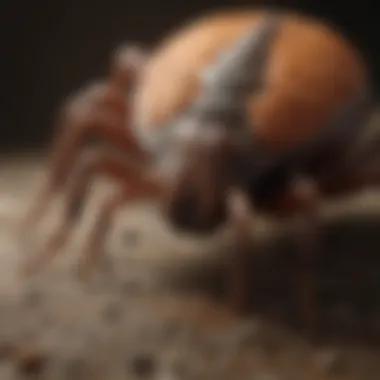Effective Strategies for Tick Removal and Prevention


Intro
Understanding Pests
Definition of Pests
Pests, in a general sense, are organisms that interfere with our quality of life, be it by damaging property, spreading disease, or simply being nuisances. When it comes to ticks, they can bite and feed on the blood of humans and animals. Ticks thrive in woody, grassy areas and are known to latch onto hosts as they pass by.
Importance of Pest Identification
Identifying ticks is crucial for effective management. There are numerous species, with the black-legged tick and the dog tick being among the most common in the United States. Knowing the specifics of each type can be pivotal in choosing appropriate removal and prevention measures.
Prevention Techniques
Home and Garden Preventative Measures
Maintaining a well-kept garden can significantly reduce the likelihood of tick infestations. Here are some effective strategies:
- Regular Yard Maintenance: Mow the lawn regularly and keep shrubs trimmed back. This reduces the habitat where ticks thrive.
- Create a Barrier: Use wood chips or gravel as a buffer between grassy areas and play areas to limit tick movement.
- Clean Up Leaves: Ticks love to hide in leaves. Raking leaves and cleaning debris can help keep your yard tick-free.
Seasonal Prevention Tips
Ticks are more active during certain times of the year, particularly in warm, humid conditions. Some tactical actions to consider include:
- Spring: Apply your preferred repellent to pets before heading out. A thorough tick check should follow.
- Summer: Wear light-colored clothing when undertaking outdoor activities, making it easier to spot any ticks.
- Fall: Keep an eye out as ticks can be abundant during early autumn, particularly after a warm spell.
- Winter: Though reduced in number, ticks can still be present. Regular checks after winter outings are also advisable.
Eco-Friendly Pest Control Solutions
Overview of Sustainable Practices
Utilizing environmental-friendly methods can be beneficial for households keen on reducing chemical usage. Practices like encouraging the presence of beneficial insects or implementing natural barriers can deter ticks effectively without the harsh effects of pesticides.
Natural Remedies and Their Effectiveness
A variety of natural repellents have been touted for their effectiveness:
- Essential Oils: Oils such as eucalyptus or lavender can repel ticks when diluted properly and applied to skin or clothing.
- Diatomaceous Earth: Sprinkling this substance around your garden can deter crawling insects, including ticks.
- Neem Oil: Derived from the seeds of the neem tree, it serves as a natural pesticide that is gentle for the environment yet repellent to ticks.
"Preventing tick bites is often simpler than treating them after the fact, making proactive strategies essential for a safe living space."
By implementing these various strategies and keeping informed about tick behavior and habitats, householders can take substantial steps towards effective tick management in their living environments. Ticks may be crafty and resilient, but an informed and proactive approach is the key to keeping them at bay.
Understanding Ticks
Understanding ticks is foundational for anyone looking to defend themselves and their loved ones from these often-overlooked pests. Grasping the behaviors, habitats, and biological makeup of ticks goes beyond mere curiosity; it's about taking actionable steps towards prevention and effective removal. Knowledge is power; when you know what ticks are, how they operate, and where they thrive, you significantly reduce the chances of encountering these creatures or getting bitten.
Tick Biology and Behavior
Ticks are not insects; they belong to a subclass known as arachnids, which means they are more closely related to spiders and scorpions. Their bodies are equipped with specialized mouthparts, allowing them to latch onto hosts and draw blood, which is vital for their growth and reproduction. Ticks have a unique behavior pattern. Most are questing, meaning they actively seek out hosts by positioning themselves on the tips of grasses and shrubs, waiting to latch onto unsuspecting passersby.
They have an interesting feeding strategy. Once attached, ticks can remain on their host for several days, gradually eating while injecting saliva that helps them hold on. Their saliva also contains anticoagulants, which prevent blood from clotting, allowing them to feed more efficiently. This can pose significant risks, as these tiny pests can transmit dangerous diseases during their prolonged feed.
Identifying Common Tick Species
Knowing the common tick species in your area is crucial for effective prevention. Two widespread varieties in North America are the deer tick and the dog tick. The deer tick is notorious for transmitting Lyme disease and is typically smaller than the dog tick. Dog ticks, on the other hand, are larger and may carry other illnesses like Rocky Mountain spotted fever.


Here are some tips for identifying these ticks:
- Color and Size: Deer ticks usually have a reddish body, especially when fed, while dog ticks possess a more mottled brown pattern.
- Location: Adult deer ticks are often found in wooded or grassy areas; dog ticks tend to be found in gardens and yards where pets roam.
- Time of Year: While ticks primarily thrive in warmer months, understand the seasonal habits to remain vigilant.
Lifecycle of Ticks
A tick's life cycle consists of four stages: egg, larva, nymph, and adult. Each stage presents opportunities for interaction with hosts. The lifecycle begins when female ticks lay hundreds to thousands of eggs, usually in fall or spring. Each tick needs a blood meal to mature from one stage to the next.
Understanding the lifecycle can help homeowners strategically time their prevention efforts. Here’s a brief outline:
- Eggs: Laid by adult females in the spring.
- Larvae: Hatch in the summer, often seeking out small mammals.
- Nymphs: Formed in the fall, nymphs are particularly dangerous due to their size and ability to transmit diseases. They feed on larger hosts and are most active in the late spring and summer.
- Adults: Typically emerge in the fall, seeking larger hosts like deer or humans to mate and begin the cycle anew.
In encapsulating the life of a tick, it offers insight into not only their biology but also how to combat their advancement in your environment.
Understanding ticks will lead to better precautions and practices both within and outside your home.
Risks Associated with Tick Bites
Ticks are often perceived as mere nuisances, but the reality is that they pose significant health risks to both humans and pets. Understanding these risks is crucial for anyone living in or frequently visiting areas where ticks thrive. Consequently, acknowledging potential dangers associated with tick bites essentially forms the backbone of effective tick management strategies. By being aware of the consequences of tick bites, families can take preventative measures seriously, ensuring a safer environment at home and during outdoor activities.
Common Tick-Borne Diseases
Tick bites can result in several diseases that range in severity. Lyme disease is perhaps the most recognized tick-borne illness, often presenting symptoms such as fever, fatigue, and a characteristic skin rash. Other notable diseases include:
- Rocky Mountain spotted fever: This illness has serious implications if not treated promptly, featuring symptoms such as high fever and a rash that begins at wrists and ankles.
- Anaplasmosis: Symptoms can mirror those of Lyme disease, but may escalate quickly, warranting attention.
- Babesiosis: Often presenting symptoms related to flu, this disease can cause severe complications in individuals with weakened immune systems.
Moreover, these ailments often require extensive medical interventions and long-term treatment plans. Thus, being vigilant about tick bites isn’t just about avoiding a bit of irritation – it’s about safeguarding health.
Symptoms of Tick-Borne Illnesses
Symptoms can differ significantly depending on the specific disease contracted from a tick. However, there are some common indicators that alert individuals to potential tick-borne illness, including:
- Unexplained fever or chills.
- Muscle or joint pain, often described as aches.
- Unusual fatigue that doesn’t dissipate with rest.
- Rash: While not everyone will develop a rash, if it does appear, it often signals an urgent need for medical advice.
If one starts feeling off after a tick bite or finds unexpected symptoms emerging, it merits attention. Early recognition can deter progression to more serious issues, offering a better prognosis for recovery.
Importance of Timely Treatment
Timely intervention is paramount when it comes to tick-borne diseases. Many of these ailments, such as Lyme disease, are much easier to treat in their early stages. Failure to address symptoms quickly can lead to long-lasting health issues, some of which may not be reversible.
Treatment options can include:
- Antibiotics: These are often the first line of defense, particularly effective in the early stages of Lyme disease.
- Supportive therapies: Depending on the illness, additional medications may be required to manage symptoms.
"Timely treatment is often the difference between a quick recovery and long-term complications."
When handling tick bites, remaining observant and responsive to your body is critical. If symptoms arise, coupled with the knowledge of prior tick exposure, don’t hesitate to consult a healthcare professional.
Immediate Tick Removal Techniques
Ticks are more than just an annoying pest; they can pose serious health risks if not removed promptly and correctly. These small arachnids can carry diseases like Lyme disease and Rocky Mountain spotted fever, making immediate removal absolutely crucial. Understanding proper techniques not only alleviates the risk of infection but also simplifies what can be a very stressful situation.
How to Remove a Tick Safely
When faced with a tick bite, the first step is to remain calm. Quickly follow these steps to remove the tick without causing it to burrow deeper and increase infection risks:
- Gather Your Supplies: You will need fine-tipped tweezers, gloves, and antiseptic wipes or rubbing alcohol. Having these handy is invaluable in a pinch.
- Position Yourself: Ensure you are in a well-lit space. Consider using a magnifying glass for better visibility, especially if the tick is small.
- Grip the Tick: With your tweezers, grasp the tick as close to your skin’s surface as possible without pinching the skin. This is key in ensuring you remove the head and not just the body of the tick.
- Pull Firmly: Pull upward with steady, even pressure. Avoid twisting or jerking the tick, as this can cause its mouth parts to break off and remain stuck in the skin.
- Dispose of the Tick: Place the tick in a sealed bag or container to save it for identification if needed.
- Clean the Area: Use antiseptic wipes or rubbing alcohol to clean the bite area thoroughly.
- Monitor the Site: Keep an eye on the bite for signs of infection or rash. If you notice anything unusual, consult a healthcare professional.'


Tools and Techniques for Tick Removal
Having the right tools at your disposal can improve the efficacy of tick removal. Here’s a rundown of the essential items you should consider:
- Fine-Tipped Tweezers: The best tool for nimbly removing ticks safely and effectively.
- Tick Removal Kits: These often include specialized tools made for tick extraction, including loops and hooks that can help grip the tick securely.
- Gloves: Wearing gloves minimizes the risk of contacting tick-borne pathogens.
- Antiseptics: For cleaning the area post-removal, antiseptic wipes or alcohol are vital for preventing infections.
Using these tools properly is essential in avoiding complications. The fine-tipped tweezers are the most recommended; they allow for precision and help to prevent any unnecessary damage to the skin.
Post-Removal Care and Monitoring
After removing a tick, monitoring the bite location is critical. Here’s what you should do:
- Clean the Area: Ensure that the bite site is cleaned properly as mentioned earlier.
- Watch for Symptoms: Over the next several weeks, you should be vigilant for the following symptoms:
- Rash or redness around the bite area
- Flu-like symptoms, such as fever or headaches
- Joint and muscle aches that weren't present before
Should you start to observe any of these symptoms, it's advisable to contact a healthcare professional promptly.
"Timely intervention can make all the difference in preventing tick-related illnesses. Always err on the side of caution, especially if symptoms develop."
As for the bite itself, you can apply a soothing cream or antifungal ointment to keep the area comfortable and help with any itching. It’s also wise to take notes on the removal date and tick appearance—this information can be helpful if medical treatment is necessary in the future.
Taking swift action while employing proper techniques greatly reduces health risks associated with tick bites. With this knowledge, you can face tick encounters with confidence.
Preventive Measures Against Ticks
Preventive measures against ticks are crucial in reducing not just their population but also the risks associated with their bites. Understanding that ticks thrive in specific environments empowers homeowners and families to take informed action. Beyond just the discomfort of a bite, ticks are vectors for various diseases that can have severe health implications. Thus, by putting preventive measures in place, one not only safeguards individual health but also contributes to a broader community effort to combat tick-related illnesses.
Personal Preventive Strategies
Taking personal responsibility is the first line of defense against ticks. Here are some strategies that one can easily incorporate into daily life:
- Clothing Choices: Wearing long-sleeved shirts and long pants can provide a physical barrier against tick bites. Tucking pants into socks is a simple yet effective way to minimize exposure. Light-colored clothing makes it easier to spot ticks, so consider wearing shades like beige or light grey.
- Regular Tick Checks: Conducting thorough tick checks after outdoor activities is essential. Areas like behind the ears, in the hair, and under the arms are common spots for ticks to hide. Encourage children to check each other, making it a part of your family routine.
- Outdoor Timing: Ticks are more active during warmer months, particularly between spring and fall. Limiting outdoor excursions during peak times can decrease tick exposure.
- Footwear: Sturdy shoes are recommended instead of sandals when heading into the woods or grassy areas. Boots not only prevent bites but also offer better protection from other insects.
By adopting these strategies, households can significantly reduce the likelihood of tick bites.
Chemical Repellents and Their Efficacy
When it comes to tick prevention, chemical repellents have a proven track record. These products usually contain active ingredients like DEET, picaridin, or IR3535, which are effective at repelling ticks.
- Understanding Efficacy: Research suggests that products with at least 20% DEET can provide several hours of protection. The Minnesota Department of Health recommends applying it to exposed skin and clothing, emphasizing that it's safe for children to use in small amounts.
- Application Tips: Apply these repellents before engaging in outdoor activities. The repellent should be sprayed directly onto clothing and shoes, as ticks often hitch a ride on fabric before making contact with skin.
- Reapplication Advice: It’s important to reapply as directed, especially after sweating or swimming, to maintain its efficacy throughout your outing.
"Prevention is not only better than cure; it’s often the only way to ensure safety from ticks."
Natural and Eco-Friendly Repellent Options
For those looking for alternatives to traditional chemical repellents, natural options can be just as effective while being less harsh on the skin and environment. Here are a few to consider:
- Essential Oils: Oil of lemon eucalyptus is hailed for its effectiveness in repelling ticks, comparable to DEET. Other essential oils like lavender, tea tree, and peppermint can also deter pests. Mixing these oils with a carrier oil before application provides safety and efficacy.
- Vinegar Solutions: A mixture of equal parts vinegar and water can be sprayed on clothes and exposed skin. While the smell might not be pleasant, vinegar acts as a deterrent for many insects, including ticks.
- Garlic Spray: Some studies suggest that consuming garlic may alter body odor, making individuals less attractive to ticks. A garlic spray can also be made to apply to yards and gardens, further enhancing deterrence.
Each of these methods offers a sustainable solution that aligns with a more eco-friendly lifestyle, benefiting both individual health and the environment. The key is identifying what works best with your lifestyle and remaining vigilant against ticks.
Environmental Control Measures
Environmental control measures are a fundamental component in the ongoing battle against ticks. It is not enough to simply remove individual ticks or apply repellents; a comprehensive strategy must address the surrounding environment where ticks thrive. By managing landscapes and controlling tick habitats, homeowners can significantly reduce the likelihood of encounters with these parasites, thus enhancing the safety of their family, pets, and gardens.
Landscape Management Techniques


Implementing effective landscape management techniques helps to create an environment that is less hospitable to ticks. Ticks often prefer areas with high humidity and plenty of shade. Therefore, one of the first steps is to trim back overgrown shrubs and grasses that might provide perfect hiding spots for these pests. Regularly mowing the lawn and raking leaves not only enhances the yard's appearance but also reduces tick habitats.
Furthermore, consider transitioning to hardscaping options in the garden, such as installing gravel pathways that can act as a barrier. This approach also limits the tick-friendly vegetation that might otherwise flourish near residential areas. Besides, planting tick-repellent plants like lavender and rosemary can deter these pests while adding aesthetic value to the garden.
Creating a Tick-Resistant Yard
Creating a tick-resistant yard involves layering various strategies aimed at making the outdoor space less inviting to ticks. Here are steps that homeowners can take:
- Create a buffer zone by clearing tall grasses and leaves around the perimeter of your yard, transitioning into hard-packed soil or mulch.
- Limit deer access by installing fences or strategically placing barriers. Deer are significant carriers of ticks, and reducing their presence can lower the tick population in your area.
- Consider wildlife feed stations away from your immediate living areas. This will not only attract wildlife but also draw them away from the places where your family spends time.
"An ounce of prevention is worth a pound of cure." This old saying holds true in the realm of tick management. By taking proactive steps, you can effectively reduce the risk of tick infestations.
The Role of Wildlife Management
Understanding and managing local wildlife plays a crucial role in effective tick control. Many wildlife species, like deer and rodents, are known carriers of ticks. Thus, it becomes essential to develop strategies that manage these populations without disrupting the local ecosystem.
Educating yourself and your community about the presence of wildlife and their behaviors helps in implementing practical solutions. For instance, creating awareness about the importance of not feeding wildlife can prevent attracting them too close to homes. Additionally, collaborating with local wildlife management programs can facilitate humane population control initiatives that benefit both humans and animals.
In summary, tackling the tick issue requires a multi-faceted approach, where environmental control measures play a pivotal role. By adopting prudent land and wildlife management strategies, homeowners can create healthier outdoor environments and hopefully minimize the risk of tick exposure. With diligence and foresight, we can foster spaces that are not only enjoyable but also safe.
Long-Term Approaches to Tick Control
Taking a long-view approach to tick control is vital for ensuring the safety and health of our families and pets. It’s not just about a quick fix after finding a tick; instead, it’s about setting up an environment that discourages these pests from taking residence in the first place. Long-term strategies help to diminish tick populations sustainably, minimizing the risk of tick-borne diseases in your community.
The benefits of such approaches are multi-faceted:
- Enhanced Safety: Continual management methods lower risks as well as prevent tick bites and the subsequent illnesses.
- Environmental Responsibility: Sustainable practices help protect beneficial species in your local ecosystem.
- Community Well-Being: Working together fosters a shared commitment to a healthier environment, ultimately promoting a happier living space for everyone.
Community-Based Tick Management Initiatives
Community participation is key when tackling tick control. Local initiatives can provide a collective strategy, integrating resources, and sharing valuable information among neighbors. Solutions can include:
- Organized Tick Checks: Regular community events focused on education and tick checks can strengthen awareness.
- Information Sharing: Social media groups, such as on Facebook or Reddit, can help spread best practices and solutions specific to your area.
- Local Volunteers: Community members can volunteer for landscaping projects that discourage tick habitats.
"United we stand, divided we fall" - this saying holds a great truth for tick management. By working together, communities can create a robust defense against ticks, ensuring no house is left vulnerable.
Research and Development of New Solutions
Scientific research and advancements play a crucial role in the long-term battle against ticks. As understanding of tick behavior and tick-borne pathogens deepens, innovative solutions emerge. Some avenues of research might include:
- Genetic Research: Modifying or enhancing the resilience of animals to reduce tick-hosts.
- Natural Predators: Exploring the use of certain animals or insects that can help manage the tick population.
- Advanced Repellents: Developing more effective and eco-friendly repellents might greatly reduce tick attraction.
Collaboration among scientists, academia, and local governments can support the development of these innovative strategies and bring them effectively into the market.
Public Awareness and Education
Knowledge is power. Empowering the public with information about tick prevention and tick removal is key. Awareness initiatives can take many forms:
- Workshops and Seminars: Hosting events focusing on ticks, their risks, and effective prevention measures.
- Use of Social Media: Sharing tips, news, and local tick reports can keep the community informed and engaged. Websites like en.wikipedia.org or britannica.com can offer foundational knowledge and updates.
- Educational Materials: Flyers, newsletters, and local ads can help reach people who may not use social media.
By increasing awareness and encouraging education, we can foster a culture of vigilance. Proactive communities tend to shoo away ticks before they settle in, paving the way for healthier living environments.
Implementing long-term tick control strategies requires patience and commitment. Yet, with focused efforts from individuals and communities alike, the odds can be shifted significantly in favor of human and animal well-being.
Ending
Summarizing Effective Tick Removal and Prevention
When it comes to effective tick removal, it’s not just about swiftly taking off these pesky parasites. It requires a systematic and informed approach that encompasses both immediate action and long-term prevention strategies. Here’s a brief summary of key points:
- Immediate Tick Removal: Knowing how to correctly remove a tick is foundational. The right tools and techniques – such as tweezers, and following a step-by-step removal method – reduce the chance of infection.
- Preventive Measures: Adopting personal preventive strategies like wearing proper clothing, conducting regular body checks, and utilizing repellents can significantly mitigate exposure.
- Environmental Control: Managing your landscape by keeping grass short and adding barriers can discourage ticks from thriving in your yard.
- Long-Term Management: Engaging in community initiatives and staying informed about research into tick control can be invaluable in reducing risk.
Investing in education, awareness, and community initiatives is pivotal in creating a sustainable approach to tick control.



